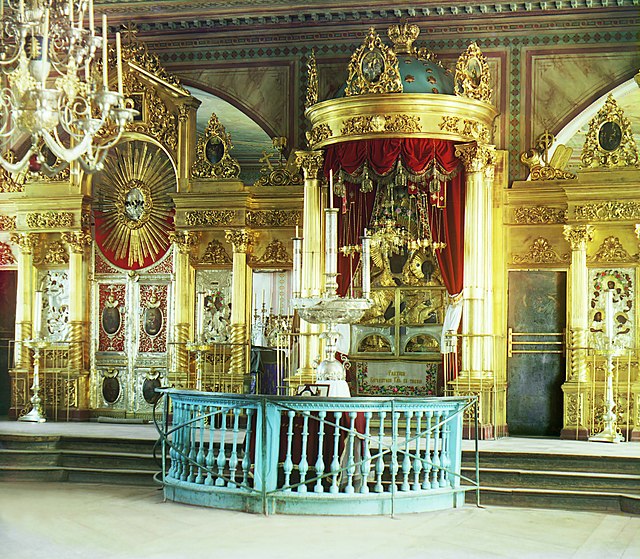Top Qs
Timeline
Chat
Perspective
Bema
Elevated platform used as an orator's podium From Wikipedia, the free encyclopedia
Remove ads
A bema is an elevated platform used as an orator's podium. The term can refer to the raised area in a sanctuary. In Jewish synagogues, where it is used for Torah reading during services, the term used is bima or bimah.
Ancient Greece

The Ancient Greek bēma (βῆμα) means both 'platform' and 'step', being derived from bainein (βαίνειν, 'to go').[1][2][3][4][5] The original use of the bema in Athens was as a tribunal from which orators addressed the citizens as well as the courts of law, for instance, in the Pnyx. In Greek law courts the two parties to a dispute presented their arguments each from separate bemas.
By metonymy, bema was also a place of judgement, being the extension of the raised seat of the judge, as described in the New Testament, in Matthew 27:19 and John 19:13, and further, as the seat of the Roman emperor, in Acts 25:10, and of God, in Romans 14:10, when speaking in judgment.
Remove ads
Judaism
This section needs additional citations for verification. (December 2021) |

In Judaism, synagogues contain a bimah (Hebrew: בּימה, platform or pulpit), a large, raised, reader's platform, where the Torah scroll is placed to be read.[6] The term is post-biblical Hebrew, and almost certainly derived from the Ancient Greek word bema. However, a link to the Biblical Hebrew bama (בּמה), 'high place' has also been suggested.
The bimah is raised to demonstrate the importance of the Torah reader, and to make it easier to hear the recitation of the Torah.[7] Over time, it became a standard fixture in synagogues, where the weekly Torah portion and haftara are read. In Orthodox Judaism, the bimah is located in the center of the synagogue, separate from the Torah ark. In other branches of Judaism, the bimah and the ark are joined together.[7]
Remove ads
Christianity
Summarize
Perspective

The ceremonial use of a bema carried over from Judaism into early Christian church architecture. It was originally a raised platform with a lectern and seats for the clergy, from which lessons from the Scriptures were read and the sermon was delivered. In Western Christianity the bema developed over time into the chancel (or presbytery) and the pulpit.
In Byzantine, Armenian Rite, West Syriac and Alexandrian Rites of Eastern Christianity bema generally remains the name of the platform which composes the sanctuary; it consists of both the area behind the iconostasion and the platform in front of it from which the deacon leads the ektenias (litanies) together with the ambo from which the priest delivers the sermon and distributes Holy Communion. It may be approached by one or several steps. The bema is composed of the altar (the area behind the iconostasion), the soleas (the pathway in front of the iconostasion), and the ambo (the area in front of the Holy Doors which projects westward into the nave). Orthodox laity do not normally step up onto the bema except to receive Holy Communion.
Islam
In Islam, the minbar "pulpit" is a standard furnishing in every congregational mosque. The earliest record of a minbar dates back to between 628 and 631.
See also
- Ambon (liturgy)
- High place, raised place of worship
- Peak sanctuaries
- Templon
- Tribune (architecture)
References
External links
Wikiwand - on
Seamless Wikipedia browsing. On steroids.
Remove ads